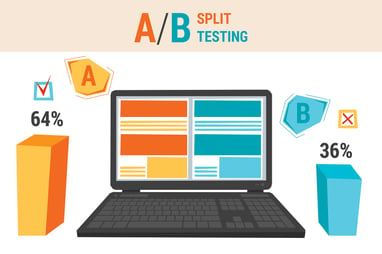
There are three overarching metrics that businesses really care about, or should care about: REVENUE, CUSTOMERS, and PROFITABILITY. These should be how you determine marketing success as a marketer, director, president or owner of a company. All of your marketing activities should be aiming to increase these ultimate numbers: if your marketing is not creating these successes, then there are aspects of your marketing efforts - whether you use inbound or traditional marketing - that need to be changed.
However, the fact that these are the ULTIMATE indicators of marketing success does not mean that they are the only indicators you should be tracking.
Marketers need to understand and consistently keep track of the health of their program if they want to achieve this larger marketing success. Think about it this way: in medicine, you don’t tell if a patient’s healing process is effective by waiting to see the end result - live or die. Instead, you carefully examine certain metrics that let you know if this patient is improving or declining in certain areas - and you adjust your strategies accordingly.
Marketing is just the same. Your marketing activities always provide a series of results or precursor metrics that you, as a stakeholder, need to examine and act upon regularly to maintain and increase success over time. These precursor metrics include website performance, landing pages, email campaigns, social media, content or blogs, influencers, and keyword ranking. In this blog, I aim to discuss each of these KPIs and help you figure out the most important metrics that you should constantly track.
Website Performance
This KPI tells us whether your website is converting the visitors who find it. It also tells you if your best salesperson - your website - is doing its job. This is essential information to know since it’s directly related to your REVENUE.
There are various factors on a website that can influence or even completely change a buyer behavior:
- Performance
- SEO
- Reachability
- Broken links
- Design and UX
- Security, etc.
These all play a role in facilitating the potential buyer in making a decision. For example, if your website takes too long to load, the buyer may lose his/her patience and bounce off your website. Similarly, if you don’t have a proper SEO strategy, your potential buyers cannot find you easily on search engines, which means you’ll most likely need to compete for every visitor (not even customer at this stage) with financial investment. Finally, if your site is not designed for good UX and people don’t feel like they can find the information they need, they will bounce. Therefore, it’s crucial that you have a good understanding of your website's performance if you want better results, i.e. increased revenue.
There are some tools, like Alexa and Website Grader, that can facilitate such tracking. In addition, there are inbound marketing agencies who use multiple tools to compare different results and provide the most accurate report and solutions for your company.
Landing Pages
First of all, let’s define landing pages. A landing page is a website page that allows you to capture a visitor's information through a lead form (HubSpot). So without exaggeration, it's safe to say that your landing pages are probably one of the most important elements in your marketing infrastructure - if you don't have anyone's information, you don't have anyone to market to. Therefore, constantly analyzing and optimizing your landing pages will ultimately generate more leads and revenue for you and your company.
How do you create an optimized landing page?
There are several elements that form a landing page, including the images, content, forms and CTAs. When we first strategize and design a landing page, we do so based on industry standards, inbound marketing best practices, and experience gathered from past clients. However, these initial executions are very general.
Next, we create more specialized, effective results by analyzing data and conducting A/B tests. When it comes to improving landing pages based on marketing analytics, A/B testing is usually the best way to proceed. A/B testing, by definition, is testing two versions of the same thing with the same goal, for the purpose of finding out which version reaches the goal faster, more efficiently, or with better results. The best way to utilize A/B testing is by changing one variant at a time and making improvements based on those results.

When A/B testing is used, the strategy and design for the landing page can be created and refined based on real data and a real understanding of what is actually working. That way, you get the true story of how your customers or clients really feel about their user or buyer experience and how likely they are to interact or respond to your offer.
Therefore, tracking your landing page KPIs is extremely crucial for your conversion and REVENUE. It also impacts how efficiently you are producing results and therefore has influence over your PROFITABILITY.
Email Campaigns
This is probably the most obvious one when it comes to the importance of tracking KPIs. As a business owner, director, or manager, you need to know all of the important metrics - like open rate and click through rate - of almost every single one of your emails.
Many companies or businesses still execute their email marketing strategy with untargeted email blasts. However, the data that can be pulled from these tends to be so general that it doesn’t tell you any useful information at all. In order to be truly effective, email campaigns should be well-targeted, timely, and personalized based on your buyer personas and Buyers Insight Report. If they are, then the data you get from them should be able to tell you how or how well your leads or prospects are moving down your marketing and sales funnel and ultimately become your CUSTOMERS.
Your email campaigns should also involve workflows, giving different buyer personas different experiences. In general, email campaigns should target people at all stages of the buyer's cycle, from those at the top of the funnel (people who don’t even know that they have a need yet) to those at the bottom of the funnel (people who are making a decision of purchasing). That way, they will affect and influence the results at all stages of your marketing or digital marketing strategy.
Overall, keeping track of the performance of your email campaigns will give you a good understanding of the health and responsiveness of your entire CRM. A well-executed email campaign can directly affect your final REVENUE and lead to higher engagement rates with your CUSTOMERS.
Social Media
Social media is no longer private and personal. Today, it's used as a major channel for many companies to provide customer service and broaden their social influence.
In our minds, Facebook, Instagram, and Twitter are the major platforms when we think of social media. However, it's worth noting that the social media industry is much broader than this, with more and more platforms being established and driving traffic every month - if not every week. In fact, Reddit experienced a 152% growth in orders in 2013 (Shopify). Such numbers and growth simply cannot be overlooked.
The data you get from social media - and the strategy that you put together with this data (KPI) - will have a huge impact on your CUSTOMER acquisition and retention. Given that social media can be a very organic form of marketing, it’s a great way to improve PROFITABILITY as well.
However, the truth is that you do not have the capability of covering every single platform when it comes to social media. Therefore, you must choose the most effective platform and ROI for YOUR company based on the data that you get from your social media marketing campaigns. Look at the numbers and find out where your audience is finding you and engaging in order to create the most effective social media marketing strategy possible.
Content or Blogs
5 years ago, when inbound marketing was still a new concept, the idea was that if you create content, people will come. However, that is not the case anymore. Content nowadays needs to provide tremendous value in order for it to be noticed, read, or shared.
So what determines the extreme value? Your audience, or the people you ultimately want to market to. However, it is simply not possible for your audience to go through every single piece of content on the internet to figure out and prioritize their readership. Instead, these prospects use tools to help them figure out where to go and what to read - search engines, social shares, etc.
Search engines like Google, Yahoo, and Bing prioritize their content by how related they think the content is to a certain search term, a query. They then use artificial intelligence to understand how well the piece of content is addressing the query. This might sound very robotic and defeat the purpose of creating good content, instead of good SEO. However, the truth is that these search engines are constantly updating their artificial intelligence. At this point, it’s fairly close to human judgment, meaning that content has to high-quality in order to rank.
Another important factor to bear in mind is that your ultimate goal is not to get visits, but CUSTOMERS. Therefore, SEO is only the very first step of being found. Once people have found you and landed on your website, you still need to work closely with your website or your sales team to close the deal.
Therefore, your content is the core of your marketing collaterals, and it determines how well your marketing strategy will be executed. This means that your marketing content and blogs need to be constantly created and updated. This will affect your SEO, your conversion rate, and ultimately the acquisition of leads and CUSTOMERS. The data you get from this KPI, then, is extremely valuable.
Influencers and Keyword Ranking
I’m by no means indicating, by putting influencers and keyword ranking together in one section, that they are one and the same thing. However, these topics do share similarities when it comes to the importance of analyzing the data from either or both. They are both ways of being found.
Your influencers are your advocates and your advertising network. Proper and effective execution of your influencer strategy will give you tremendous ROI, and this metric should be constantly measured and facilitated for more CUSTOMERS and PROFITABILITY.
Your keyword ranking is vital to your discoverability online. You might have a website that converts every single visitor - but if nobody is landing on your website, that means that you're getting zero customers. Therefore, you have to make sure that your keyword ranking strategy is working and giving you the visitors that you need. Ultimately, this will lead to more REVENUE and CUSTOMERS.
I think you are seeing where I’m going with this now. Yes, there are ultimate KPIs that an owner of the company will care about, and those are the ones that ultimately determine the success and failure of a company. However, there are also precursor KPIs that are absolutely necessary to track on a regular basis. And at EYEMAGINE we measure all of them. We have 6 pages of KPIs that we track on a monthly basis to ensure successful execution of marketing strategies and, ultimately, increases in revenue, customer, and profitability of our clients. We are completely transparent with the monthly performance: every month, we share our results with our clients their KPI Scorecard. We even color-code (red - yellow - green) each result so our clients can see at a glance how well their program is working.
If you would like to discuss how to track these KPIs for your company, feel free to schedule a discussion with us.

